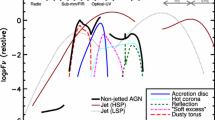Abstract
The chemical evolution of the Galaxy with a pulsating active nucleus is investigated. The surface densities of gas, stellar remnants, stars and chemical species such as helium and heavy elements inZ≧6 are calculated as functions of the position in the Galaxy and of the evolutional time of the Galaxy. According to this model, the entire luminosity of the galactic disk becomes almost constant at some 2×109 yr after the galactic formation, but the nuclear bulge, whose dimensions gradually diminishes, becomes more and more luminous with time. On the other hand, the abundance depletion of helium and heavy elements appears in the inner region of the disk after some 6×109 yr of the galactic formation. It also becomes clear that the activity for the nucleosynthesis in the nucleus is limited only in the early history of the Galaxy and has been reduced rapidly with time. Using this model, we can account for the observed phenomena such as the smooth dependence of the elemental abundance in the halo population on the distance from the galactic center, the high abundance of heavy elements in quasar spectra and etc.
Similar content being viewed by others
References
Arnett, W. D.: 1971,Astrophys. J. 166, 153.
Arp, H. C.: 1965, in A. Blaauw and M. Schmidt (eds.),Galactic Structure, University of Chicago Press, Chicago, p. 401.
Bahcall, J. N. and Kozlovsky, B. Z.: 1969,Astrophys. J. 155, 1077.
Böhn-Vitense, E., Holweger, H., and Kohl, K.: 1963,Astrophys. J. 138, 604.
Burbidge, G. R. and Hoyle, F.: 1963,Astrophys. J. 138, 57.
Churchwell, E. and Mezger, P. G.: 1973,Nature 242, 319.
Colgate, S. A.: 1967,Astrophys. J. 150, 163.
Davidson, K.: 1972,Astrophys. J. 171, 213.
Einasto, J.: 1972,Astrophys. Letters 11, 195.
Freeman, K. C.: 1970,Astrophys. J. 160, 811.
Hartwick, F. D. A.: 1971,Astrophys. J. 163, 431.
Hattori, T., Nakano, T., and Hayashi, C.: 1969,Prog. Theor. Phys. 42, 781.
Hohenberg, C. M.: 1969,Science 166, 212.
Huchtmeier, W. K. and Batchelor, R. A.: 1973,Nature 243, 155.
Ikeuchi, S., Sato, H., Sato, T., and Takeda, H.: 1972,Proc. Theor. Phys. 48, 1885.
Ishida, K.: 1964,Suppl. Prog. Theor. Phys., No.31, 116.
Kumar, S. S.: 1967,Icarus 6, 136.
Larson, R. B.: 1972a,Nature Phys. Sci. 236, 7.
Larson, R. B.: 1972b,Nature 236, 21.
Larson, R. B. and Starrfield, S.: 1971,Astron. Astrophys. 13, 190.
Limber, D. N.: 1960,Astrophys. J. 131, 168.
Lin, C. C. and Shu, F. H.: 1964,Astrophys. J. 140, 646.
Lin, C. C. and Shu, F. H.: 1966,Proc. Nat. Acad. Sci. 55, 229.
Mathews, W. D.: 1972,Astrophys. J. 174, 101.
Matsuda, T.: 1970,Prog. Theor. Phys. 43, 1491.
Morgan, W. W.: 1959,Astron. J. 64, 432.
Ohnishi, T.: 1969,Publ. Astron. Soc. Japan 21, 307.
Ohnishi, T.: 1973,Astrophys. Space Sci. 25, 217.
Peebles, P. J. E. and Dicke, R.: 1968,Astrophys. J. 154, 891.
Peimbert, M. and Spinrad, H.: 1970,Astron. Astrophys. 7, 311.
Perek, L.: 1962,Adv. Astron. Astrophys. 1, 165.
Ouirk, W. J.: 1972,Astrophys. J. 176, L9.
Quirk, W. J. and Tinsley, B. M.: 1973,Astrophys. J. 179, 69.
Reddish, V. V.: 1966,Vistas Astron. 7, 173.
Reddish, V. C.: 1968,Quart. J. Astron. Soc. 9, 409.
Reddish, V. C. and Wickramasinghe, N. C.: 1969,Monthly Notices Roy. Astron. Soc. 143, 189.
Rees, M. J., Sciama, D. W., and Setti, G.: 1968,Nature 217, 326.
Reeves, H.: 1972,Astron. Astrophys. 19, 215.
Reeves, H., Audouze, J., Fowler, W. A., and Schramm, D. N.: 1973,Astrophys. J. 179, 909.
Roberts, M. S.: 1969,Astron. J. 74, 859.
Rubin, V. C. and Ford, W. K. Jr.: 1970,Astrophys. J. 159, 379.
Salpeter, E. E.: 1955,Astrophys. J. 121, 161.
Salpeter, E. E.: 1959,Astrophys. J. 129, 608.
Sanders, R. H.: 1970,Astrophys. J. 162, 791.
Sanduleak, N.: 1969,Astron. J. 74, 47.
Schmidt, M.: 1959,Astrophys. J. 129, 243.
Schmidt, M.: 1963,Astrophys. J. 137, 758.
Schwarzschild, M. and Härm, R.: 1959,Astrophys. J. 129, 637.
Searle, L.: 1971,Astrophys. J. 168, 327.
Searle, L. and Sargent, W. L. W.: 1972,Astrophys. J. 173, 25.
Searle, L., Sargent, W. L. W., and Bagnuolo, W.: 1973,Astrophys. J. 179, 427.
Shklovsky, I. S.: 1965,Soviet Astron.-AJ 8, 638.
Stothers, R. and Simon, N. R.: 1970,Astrophys. J. 160, 1019.
Talbot, R. J., Jr. and Arnett, W. D.: 1971,Astrophys. J. 170, 409.
Talbot, R. J., Jr. and Arnett, W. D.: 1973,Astrophys. J. 186, 51.
Tinsley, B. M.: 1968,Astrophys. J. 151, 547.
Truran, J. W. and Cameron, A. G. W.: 1970,Nature 225, 710.
Truran, J. W. and Cameron, A. G. W.: 1971,Astrophys. Space Sci. 14, 179.
Truran, J. W., Hansen, C. J., and Cameron, A. G. W.: 1965,Can. J. Phys. 43, 1616.
Unno, W.: 1971,Publ. Astron. Soc. Japan 23, 123.
Unsöld, A. O.: 1969,Science 163, 1015.
Vaucouleurs, G. de: 1972,Nature Phys. Sci 239, 139, and references therein.
Wasserburg, G. J., Schramm, D. N., and Huneke, J. C.: 1969,Astrophys. J. 157, L91.
Author information
Authors and Affiliations
Rights and permissions
About this article
Cite this article
Ohnishi, T. A galactic model with a pulsating active nucleus. Astrophys Space Sci 28, 325–350 (1974). https://doi.org/10.1007/BF00641931
Received:
Issue Date:
DOI: https://doi.org/10.1007/BF00641931




